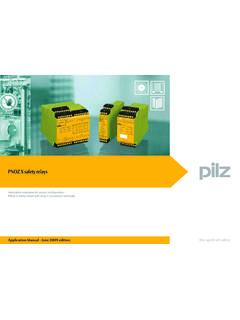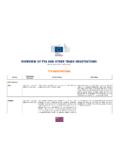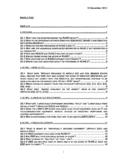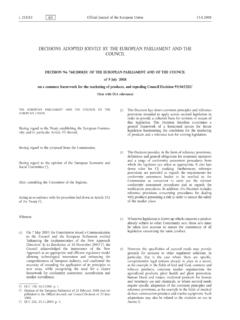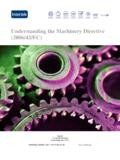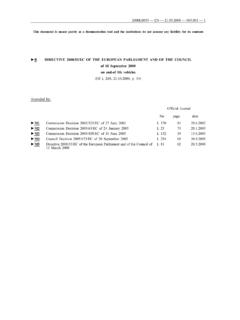Transcription of ATEX Directive 94/9/EC - EUROPEAN DIRECTIVES
1 ATEX Directive 94/9/EC - EUROPEAN DIRECTIVES . GENERAL. The accidental ignition of an atmosphere containing a large quantity of gas, vapour, mists and/or dust may cause an explosion. Specific measures have been taken on an international level in order to avoid any material damage or the loss of human lives. These measures mainly apply to chemical and petrochemical industries where such hazardous atmospheres may be developed during the production, transformation, transport and storage of flammable products. They also cover installations where combustible dust is produced in the processing of pulverised and grain products (grinding and sieving). some DEFINITIONS. B. What is a potentially explosive atmosphere? 3 elements must be combined to trigger an explosion: A The oxygen in the surrounding air = always present B A flammable substance (gas, vapours, mists or dusts).
2 C A source of ignition: Electrical equipment / installation or any source of heat A spark or a flame are not the only sources of ignition. An increase of the surface temperature of an electrical equipment may cause an explosion if it exceeds the ignition temperature of the surrounding gas or mixture of substances. A C. Removing just one of the 3 elements What is an explosive atmosphere? eliminates the entire risk This is an atmosphere which could become explosive (the danger is potentially present) due to the local or operational condition in an installation such as: leaks, rupture of pipeline, temperature variations, etc. What is a gaseous or dusty explosive atmosphere? This is a mixture with air, under atmospheric conditions, of flammable substances in the form of gases, vapours, mists or dusts in which, after ignition has occurred, combustion spreads to the entire unburned mixture (definition according to Directive 1999/92/EC).
3 What is the fundamental difference between a gaseous and a dusty atmosphere? It's the density. The density of gases and vapours is approximately 1,000 times less than that of dusts. Gases are dispersed in the air due to convection and diffusion, thereby creating a homogeneous atmosphere. Since dusts are much heavier than air, they have the tendency to settle to the bottom more or less quickly. Availability, design and specifications are subject to change without notice. All rights reserved. What are the characteristic features of an explosive atmosphere caused by dust? For a dusty atmosphere to become explosive, the following four conditions must be present: - The dust must be flammable (particle size < mm in general). - The atmosphere must contain an oxidiser (generally oxygen, even in a very small quantity).
4 - The dusts must be in suspension. (The explosion will be caused by the extremely rapid rate of combustion of the dust in the oxygen in the air.). - The dust concentration must be in the explosive range. (As a rule, the lower limit of explosion is around 50 g/m .). OBJECTIVES OF THE ATEX Directive 94/9/EC ( ATmosph res EXplosibles ). To ensure free circulation of the products to which it is applicable throughout the territory of the EUROPEAN Union. To remove barriers to trade via the New Approach by requiring a definition of essential requirements regarding safety and health by which a high level of protection will be ensured (Annex II of Directive 94/9/EC ). To cover by a single Directive both mining and surface equipment. X020GB-2009/R0 - X020-07-010. To increase the scope as compared to national regulations by providing for the first time essential safety and health requirements for: - Non-electrical equipment intended for use in potentially explosive atmospheres [EN 13463-1 (2001)].
5 - Equipment intended for use in dusty environments as well as protective systems;. - Devices intended for use outside explosive atmospheres which are required for or contribute to the safe functioning of equipment or protective systems. X020-25. 25 12/2/2009 12:29:16 PM. ATEX Directive 94/9/EC - EUROPEAN DIRECTIVES . WHAT obligations DOES the manufacturer HAVE UNDER this Directive ? The manufacturer has sole and ultimate responsibility for the conformity of his product to the applicable DIRECTIVES . He bears responsibility for: - Ensuring the conformity of his products to the Directive (providing for certificates of conformity);. - Designing and constructing his products in accordance with the essential safety and health requirements;. - Following the procedures for the assessment of the conformity of the product.
6 EFFECTIVE DATE. Since 1 July 2003, all products placed on the market in the EUROPEAN Union have to conform to Directive 94/9/EC . Already installed equipment need, however, not be replaced by equipment conforming to the ATEX Directive . WHAT ABOUT THE PRODUCTS AFTER 30 JUNE 2003? After 30 June 2003, conformity to the ATEX Directive is obligatory in order to enable free movement of products throughout the EUROPEAN Union. Only the New Approach remains valid. It takes into account: - Hazardous areas;. - CE Marking;. - Dust atmospheres;. - The CENELEC standards EN 60079-0 (EN 50014) for electrical equipment for explosive gas atmosphere;. - Standard EN 13463 for non-electrical equipment for potentially explosive atmospheres. WHAT ABOUT THE PRODUCTS AFTER 1 JULY 2006?
7 After 1 July 2006, standards EN are progressively replaced by the EN 60079 series of standards in the list of harmonised standards. The same applies for EN 50281-1-1 (electrical apparatus for the use in the presence of combustible dust) which is replaced by the EN 61241 series of standards. If the equipment is not affected by substantial modifications of the new standards, the manufacturer does not need to apply for an addition to the EC type-examination certificate. Status of the harmonisation of these standards at the end of 2006: EN 50014 Replaced by EN 60079-0. EN 50018 d Replaced by EN 60079-1. EN 50019 e Replaced by EN 60079-7. EN 50020 i To be harmonised by 1 October 2009, then replaced by EN 60079-11. EN 50021 n Replaced by EN 60079-15. EN 50028 m Replaced by EN 60079-18.
8 EN 50281-1-1 Replaced by EN 61241-0 and EN 61241-1. WHAT IS THE IECEx CERTIFICATION? Availability, design and specifications are subject to change without notice. All rights reserved. The IECEx International Certification Scheme is a voluntary certification system. It offers a certification of conformity with the IEC. series of standards 60079, 61241 and 61779. This certification facilitates the international trade of electrical equipment intended for use in explosive atmospheres and contributes to avoiding the multiplicity of national certifications while guaranteeing an adapted level of safety. The certification is issued by an organisation recognised by IECEx, an ExCB (Ex Certification Body). - It provides direct access to the markets in Australia, New Zealand etc.
9 - It simplifies access to local certifications in Russia, China, USA etc. - It reduces the time and costs for certification due to its international recognition. - All certificates issued are available for download worldwide under Online Certificates at WHAT ARE EQUIPMENT PROTECTION LEVELS (EPLs)? The degree of hazard is currently defined according to the probability of the occurrence of explosive atmospheres. Equipment Protec- tion Levels (EPLs) are introduced to enable an alternative approach to selecting Ex equipment by taking into account the potential consequences of an explosion and other factors such as the toxicity of materials. X020GB-2009/R0 - X020-07-010. A risk assessment approach for the acceptance of explosion protected equipment has been introduced to clearly indicate the inherent ignition risk of the equipment, no matter what type of protection is used.
10 X020-26. 26 12/2/2009 12:29:16 PM. Standardisation organisations - EUROPEAN DIRECTIVES . IEC / CENELEC cooperation The main CENELEC EN 50014 standard (General Requirements) pertaining to electrical apparatus for potentially explosive atmospheres was originally published in 1977. It is derived from the IEC Publications 79. From that date, these 2 organisations have constantly intensified their cooperation. The new series of standards 6 (60079-0, etc.) which gradually replace the old standards are an example for the approximation between EUROPEAN and international standards. WhAT are these 2 organisations? IEC. IEC. The "International Electrotechnical Commission" (IEC), founded in 1906, has its head Commission EUROPEAN of the EUROPEAN Free Trade office in Geneva.










